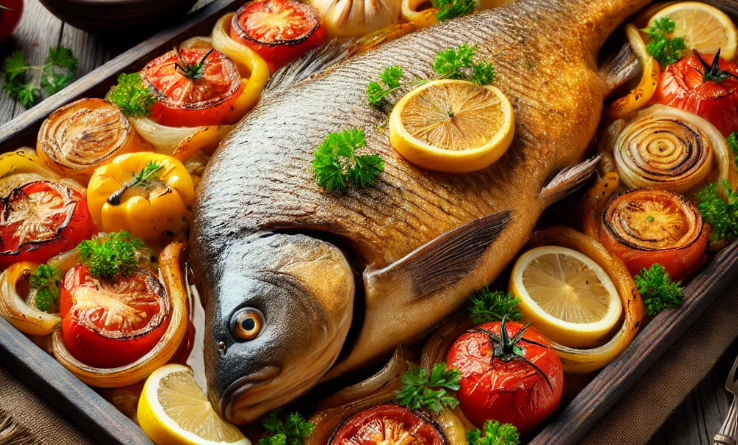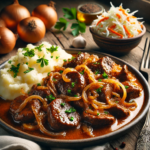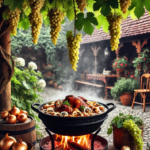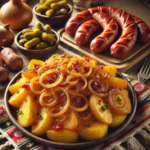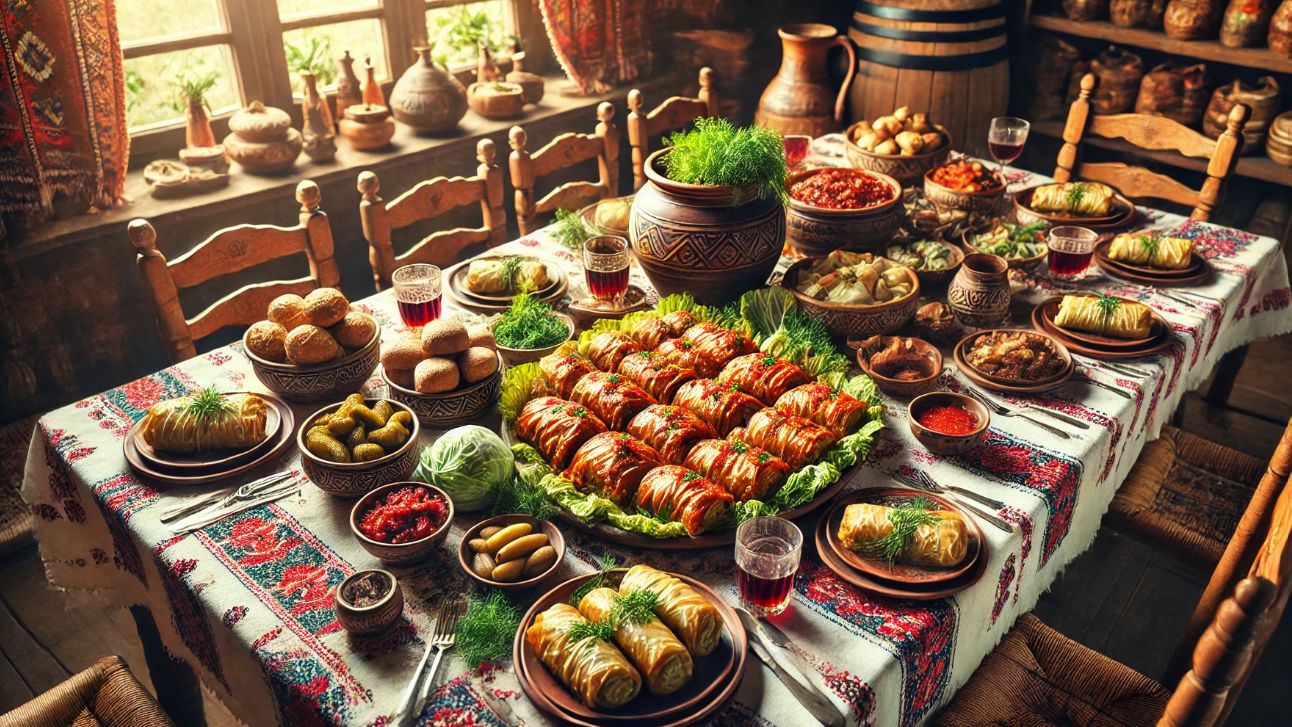Carp “à la Dniester”
Carp “à la Dniester” is a delicious traditional recipe, known for its authentic, rustic flavor, perfect for those who love fish cooked in a hearty style. Here’s how to prepare this dish:
Ingredients:

- 1 fresh carp (1.5–2 kg), cleaned and rinsed
- 2–3 large onions
- 3–4 ripe tomatoes (or 200 g tomato purée)
- 4 champignon mushrooms
- ⅓ zucchini
- 2–3 garlic cloves
- 2 bell peppers (red or yellow)
- 200 ml dry white wine
- 100 ml sunflower or olive oil
- 1 bunch fresh parsley
- 1 teaspoon sweet paprika
- Salt and pepper, to taste
- 1 lemon (for garnish and drizzling)
- 1–2 bay leaves (optional)
Method of Preparation:
- Preparing the Carp:
Rinse the carp well and pat dry.
Lightly score the fish on each side, every 2–3 cm.
Drizzle with lemon juice and season with salt, pepper, and paprika. Marinate for 15–20 minutes. - Preparing the Vegetables:
Slice onions, tomatoes, and peppers thinly.
Finely chop the garlic. - Layering in the Pan:
Grease a large baking dish with oil.
Arrange a layer of onions, then peppers and tomatoes.
Place the carp on top, sprinkle with garlic, then add mushrooms and zucchini slices. - Adding the Liquids:
Pour the white wine over the fish and vegetables.
If needed, add about 100 ml water to ensure enough liquid in the dish. - Baking:
Cover the dish with foil or a lid.
Bake in a preheated oven at 180 °C for 30 minutes.
Remove the foil, baste the carp with the pan sauce, and roast for another 15–20 minutes to achieve a lightly crisped top. - Serving:
Transfer the carp to a platter with the roasted vegetables.
Garnish with chopped parsley and lemon slices.
Serving Suggestions:
Serve the carp with warm polenta and garlic sauce (mujdei).
A glass of dry white wine completes the culinary experience.
What makes “Carp à la Dniester” so special?
This recipe is special for its simple, natural flavors that highlight fresh fish. Traditional ingredients like roasted vegetables, white wine, sweet paprika, and garlic create a balanced, savory taste. The rustic cooking style of the Dniester region adds authenticity.
How to choose the right carp?
Select a fresh carp with clear eyes, pinkish gills, and shiny skin, without any off-putting odors. A 1.5–2 kg carp ensures juicy, tender meat. Wild carp has a stronger flavor, but high-quality farmed carp also works.
What is the role of white wine?
White wine brings acidity and complexity to the sauce, balancing the sweetness of the vegetables and the fish’s natural richness. It also helps tenderize the carp during baking, resulting in succulent, tender meat.
Why score the carp before cooking?
Scoring allows seasonings to penetrate the flesh more effectively and ensures even cooking, preventing the fish from curling.
What role do the vegetables play?
Vegetables like onions, tomatoes, peppers, and zucchini contribute moisture and flavor, forming a flavorful bed that protects the fish and creates a rich pan sauce. Mushrooms add a pleasant earthy note.
How to intensify the flavors?
Add crushed garlic cloves directly to the wine, bay leaves, or a pinch of chili flakes for extra heat. Using a full-bodied white wine or a demi-sec variant brings more sweetness.
Best accompaniments for “Carp à la Dniester”?
Polenta and mujdei are classic companions. Other options include boiled potatoes, fresh cabbage salad, or grilled vegetables for a refreshing contrast.
Why cover the dish at first?
Covering with foil retains steam, ensuring even cooking and juicy fish. Removing the foil at the end allows the carp to develop a lightly browned, crisp finish.
How to check for doneness?
The fish is done when the flesh turns opaque and flakes easily with a fork. An internal temperature of 60–63 °C confirms perfect cooking without dryness.
How to make it festive?
For a festive presentation, decorate with thin lemon slices, fresh parsley, and bright bell pepper strips. Serve on a large platter with polenta molded into rounds and a pot of mujdei alongside. A glass of dry white wine completes the elegant spread.
